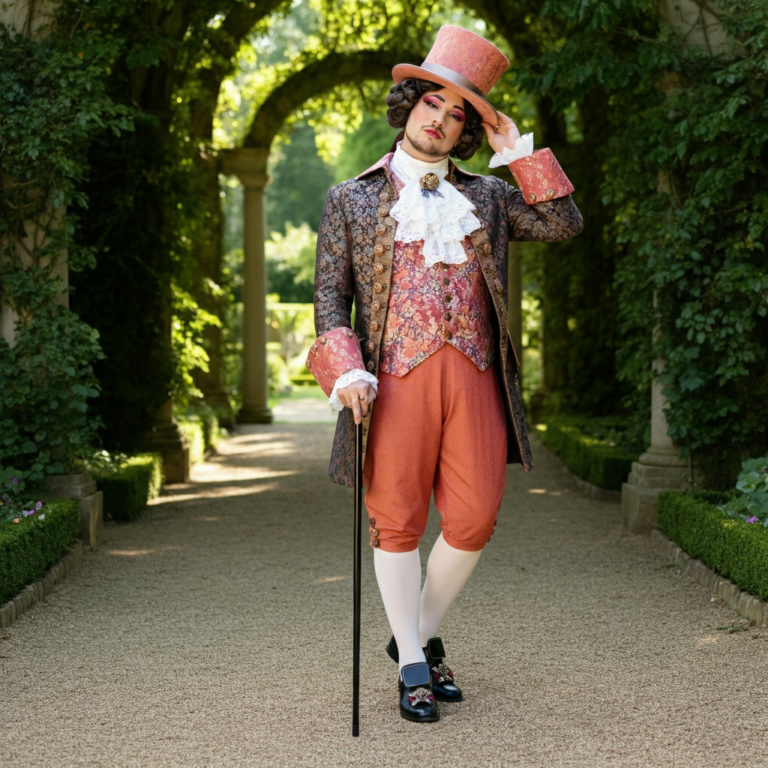Fashion has always been a form of self-expression, but few styles challenge conventional norms, like ouji fashion. This captivating Japanese alternative fashion movement draws from centuries of European aristocratic menswear while creating something entirely new and inclusive. Also known as “prince fashion,” ouji represents more than just clothing—it’s a statement of artistic freedom that welcomes anyone brave enough to embrace its whimsical elegance.
This comprehensive guide explores the rich history, defining elements, and modern evolution of ouji fashion. Whether you’re discovering this style for the first time or looking to deepen your understanding, you’ll learn how to incorporate ouji elements into your wardrobe and where to find authentic pieces that capture the essence of this remarkable fashion subculture.
Table of Contents
Understanding Ouji Fashion: Origins and Identity
What Makes Ouji Fashion Unique?
Ouji fashion, literally meaning “prince” in Japanese, emerged as a distinctive alternative fashion style that serves as a counterpart to the more widely known Lolita fashion. This visual subculture originated in Japan and draws its primary inspiration from European menswear of the eighteenth and nineteenth centuries, blending historical elegance with contemporary Japanese aesthetics.
The style is also commonly referred to as “boy style” within fashion communities. Interestingly, Western communities once used the term “kodona” to describe this fashion, though this name has largely fallen out of favour. Ryutaro Arimura coined the term during a Gothic Lolita Bible interview but never gained widespread acceptance in Japan itself.
Historical Influences and Cultural Connections
The roots of ouji fashion date back to the refined menswear of European aristocracy during the 1700s and 1800s. Think of the elegant silhouettes worn by young noblemen—fitted jackets, decorative vests, knee-length breeches, and polished boots. These historical garments provide the foundation for modern ouji interpretations.
Beyond historical fashion, ouji draws heavily from Japanese media culture, including manga, anime, and music subcultures. Characters from popular series often embody the princely aesthetic, featuring elaborate costumes that blend fantasy elements with period-appropriate details. This media influence has helped shape the whimsical aspects that distinguish ouji from purely historical recreation.
Essential Elements of Ouji Style
Core Garments and Silhouettes
The ouji aesthetic centres around creating a refined, aristocratic silhouette that emphasizes elegance and attention to detail. Key garments include:
Blouses and Shirts: Crisp white or cream-coloured blouses form the foundation of most ouji outfits. These often feature decorative elements like ruffles, lace trim, or puffy sleeves that add romantic flair while maintaining masculine undertones.
Vests and Waistcoats: Fitted vests are essential for achieving the proper ouji silhouette. These pieces often feature ornate buttons, brocade patterns, or contrasting trim that adds visual interest to the ensemble.
Jackets and Coats: Tailored jackets with military-inspired details, such as gold braiding or decorative buttons, help complete the princely look. Longer coats with cape-like elements are also popular choices.
Short Trousers and Knickerbockers: Knee-length pants or knickerbockers paired with long socks or stockings create the characteristic lower-body silhouette associated with historical menswear.
Color Palettes and Fabric Choices
Ouji fashion embraces both subtle and dramatic colour schemes. Traditional palettes include:
- Classic combinations: Black and white, navy and gold, or deep burgundy with cream
- Monochromatic schemes: All-black or all-white ensembles for dramatic impact
- Rich jewel tones: Deep emerald, sapphire blue, or amethyst purple for luxury appeal
Fabric selection plays a crucial role in achieving the proper ouji aesthetic. Preferred materials include:
- Velvet: Adds richness and texture, particularly popular for vests and jackets
- Brocade: Provides ornate patterns and historical authenticity
- Cotton and linen: Offers comfort and breathability for blouses and shirts
- Wool: Essential for structured pieces like jackets and coats
Accessories That Complete the Look
Accessories are vital for achieving an authentic ouji appearance. Essential pieces include:
Headwear: Mini top hats, berets, or decorative headbands add aristocratic flair. These accessories often feature ribbons, feathers, or small ornamental details.
Footwear: Knee-high boots, Oxford shoes, or Mary Jane shoes complement the historical aesthetic. Boots are particularly popular and often feature buckles, laces, or decorative elements.
Statement Pieces: Walking canes, pocket watches, monocles, or decorative brooches serve as conversation starters and period-appropriate accessories.
Jewellery: Subtle pieces like signet rings, chain necklaces, or cufflinks add refinement without overwhelming the look.
The Evolution of Ouji Fashion
Traditional Foundations
Early ouji fashion adhered closely to historical menswear patterns, prioritizing accuracy and traditional silhouettes. Practitioners focused on recreating the elegant proportions and refined details of eighteenth and nineteenth-century European aristocratic dress.
This traditional approach emphasized quality construction, period-appropriate fabrics, and historically accurate colour combinations. Many early enthusiasts studied museum collections and historical portraits to ensure their interpretations remained faithful to the original inspiration.
Modern Interpretations and Innovation
Contemporary ouji fashion has evolved to embrace more creative freedom and personal expression. Modern practitioners blend traditional elements with:
Avant-garde details: Unconventional fabric combinations, asymmetrical cuts, or unexpected colour pairings
Casual adaptations: Simplified versions suitable for everyday wear rather than special occasions
Cultural fusion: Elements from other fashion subcultures or cultural traditions
Sustainable practices: Vintage pieces, handmade items, or ethically sourced materials
Media Influence and Subculture Growth
Japanese media continues to influence ouji fashion evolution. Popular manga series, anime characters, and music videos showcase innovative interpretations that inspire new trends within the community. Visual kei musicians, in particular, have embraced ouji elements, helping popularize the style among younger audiences.
Social media platforms have also accelerated the style’s global spread, allowing international communities to share inspiration, coordinate group events, and connect with like-minded individuals worldwide.
Breaking Gender Boundaries: Who Can Wear Ouji?
Inclusive Fashion for All
Despite its masculine-coded historical origins, ouji fashion is explicitly inclusive and welcomes practitioners of all gender identities. The style’s appeal lies in its artistic expression rather than gender conformity, making it accessible to anyone drawn to its aesthetic principles.
Both men and women actively participate in ouji fashion communities throughout Japan and internationally. This inclusivity reflects the emphasis of the broader alternative fashion movement on personal expression over traditional gender norms.
Styling Tips for Different Body Types
Ouji fashion can be adapted to flatter various body types through strategic styling choices:
For shorter torsos: High-waisted trousers and shorter jackets help elongate the silhouette
For longer torsos: Longer vests and dropped-waist details create a better proportional balance
For broader shoulders: Structured jackets with defined waistlines create an elegant silhouette.
For narrower frames: Layering pieces and textured fabrics add visual weight and interest
The key is understanding how different garments interact with your natural proportions and adjusting accordingly while maintaining the style’s core aesthetic principles.
Finding Ouji Fashion: Shopping and Sourcing
Specialized Brands and Retailers
Several brands specialize in ouji fashion, offering both traditional and contemporary interpretations:
Japanese brands often provide the most authentic pieces, though international shipping may be necessary. These brands typically offer the highest quality construction and the most accurate historical details.
International retailers have emerged to serve growing global demand, often offering more affordable options or pieces adapted for different body types.
Online marketplaces provide access to both new and vintage pieces, allowing for more budget-friendly options and unique finds.
DIY and Thrifting Strategies
Creative individuals can build ouji wardrobes through alternative approaches:
Thrift shopping: Vintage stores often carry pieces that can be incorporated into ouji outfits with minimal modification
Sewing and alterations: Basic sewing skills allow the customization of existing pieces or the creation of unique items
Accessory crafting: Many ouji accessories can be handmade or modified from existing items
Pattern adaptation: Historical sewing patterns can be adapted for modern materials and sizing
Building a Versatile Ouji Wardrobe
Start with foundational pieces that can be mixed and matched:
- One high-quality white blouse as the base for most outfits
- A well-fitted vest in a neutral colour like black or navy
- A pair of knee-length trousers in a versatile fabric
- Quality boots that complement multiple outfits
- Essential accessories like a hat or decorative brooch
Additional pieces can be added gradually based on personal preferences and budget constraints.
Frequently Asked Questions About Ouji Fashion
What’s the difference between ouji and Lolita fashion?
While both styles originated in Japan and share some aesthetic elements, ouji fashion draws from masculine historical clothing, while feminine Victorian and Rococo styles inspire Lolita fashion. Ouji emphasizes princely elegance and aristocratic menswear, while Lolita focuses on doll-like femininity and elaborate dresses.
Is ouji fashion expensive?
Like most alternative fashion styles, ouji can range from budget-friendly to expensive, depending on your approach. Brand-new pieces from specialized retailers tend to be costly, but thrifting, DIY projects, and gradual wardrobe building can make the style more accessible. Many practitioners start with basic pieces and add more elaborate items over time.
Can I wear ouji fashion to everyday events?
Absolutely! Many ouji enthusiasts create simplified versions of the style, suitable for school, work, or casual outings. The key is adapting the aesthetic principles to fit your lifestyle and environment while maintaining the core elements that make ouji recognizable.
Do I need to strictly follow historical accuracy?
Not at all. While some practitioners prefer historically accurate interpretations, ouji fashion welcomes creative freedom and personal expression. Modern interpretations often blend traditional elements with contemporary details, creating unique looks that reflect individual style preferences.
Where can I learn more about ouji fashion?
Online communities, social media groups, and fashion forums provide excellent resources for learning about ouji fashion. Many cities also have alternative fashion meetups or conventions where you can connect with other enthusiasts and see the style in person.
Is there a specific way to wear makeup with ouji fashion?
Makeup in ouji fashion varies widely based on personal preference. Some practitioners prefer natural looks that don’t compete with the clothing, while others embrace dramatic makeup that complements the theatrical nature.


